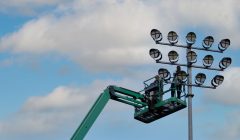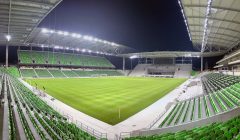Considering Houston commercial LED lighting? The Department of Energy (DOE) states that LED (light-emitting diode) lighting is the most-efficient lighting technology we have today. The post we linked to goes on to say how commercial LED lights are much more energy efficient than the traditional types of lighting, and also how they are different from the traditional lights.
But when it comes to any type of lighting, the lifespan turns out to be one of the most important factors. So we will be discussing exactly that in this post, while also taking help from the research the DOE has made in order to back our claims.
Table of Contents
ToggleSo, How Long Do LED Lights Really Last?
There have been a lot of reports about the lifespan of commercial LED lights. Most have estimated it to be well between 50,000 to 100,000 hours. However, some recent reports revise it down to more like the 25,000 to 50,000 hours range.
Furthermore, some reports even say that the claims of LED lights having a much higher lifespan – especially anything above 20,000 hours – are not accurate. So, what’s the truth?
Well, first things first, a lot depends on the type of light you choose. Just like with any other type of light, the quality of LED bulbs or lights you choose would have a huge role to play in how long they last for you.
Second, the conditions they are installed in also turn out to be just as important, which we will get to in a bit.
But let us talk about the general lifespan of commercial LED lights first. As we mentioned, it’s as high as 50,000 hours or more according to some sources. But if the report by the DOE is anything to go by, then good-quality commercial LED bulbs should last you 25,000 hours or more.
Now, while this is much shy of the 50,000 to 100,000 hours range many sources claim, it’s definitely nothing to frown at given that comparable traditional light bulbs fail to deliver for more than 1000 hours, something which the same DOE report we quoted above notes as well.
So, this makes it pretty clear that while most LED lights may not last you anywhere near 100,000 hours, or even 50,000 hours for that matter, they are still way ahead than the other lighting options in terms of the lifespan.
Also let’s not forget that they are incredibly more cost-effective and energy efficient than all the other lighting options out there, meaning that you would also have some significant energy cost savings over time with LED lighting.
But They Do Fail Before They Are Supposed To!
It appears that many of the reports that claim LED lights don’t last anywhere as long as they claim to, may be due to the fact that LED lights do fail in certain conditions or due to certain factors. Let’s understand them in more detail below.
Overheating
LED lights can be extremely vulnerable to overheating. And no, it’s not just the environment. Your commercial LED lights may be overheating even when you have enough air conditioners in your commercial facility.
The thing is, the most common type of overheating issues are caused due to poorly designed heatsinks. While some of them do not leave enough surface area, some just don’t manage to provide the kind of air flow LED lights need to avoid encountering overheating issues.
In fact, some heatsinks are so poorly designed that instead of dispensing heat away from the LEDs, they “gather” the heat around them to make them heat even more than they would without the heatsinks.
So the next time your LED bulbs fail much sooner than you expected them to, be sure to get the design of your heatsinks checked before blaming the LED technology.
Capacitors
In most instances of the LED lights failing much before they should have, it was found that it was usually never the LED part of the light that failed, but one of the other parts. Many of them fail due to overheating as we explained above, while some LED lights fail due to the capacitor getting damaged.
Unfortunately, the revolutionary LED lighting technology has to work with capacitors that are mostly made of plastic. It’s not surprising for them to end up in a damaged state in just a year or so.
This is the reason it’s important to choose high-quality LED lights. Nowadays many manufacturers have started using ceramic capacitors instead of the plastic ones for their higher priced LED light options, which have a much, much larger lifespan than their plastic counterparts.
Environment
Of course, the environment plays a crucial role in deciding the fate of your commercial LED lights as well. For one, LED lights designed with keeping one country in mind may not function as well or anywhere near as long in some other country than the country they were designed for.
This could be due to a multitude of factors, but they particularly include the weather and the climate.
Similarly, commercial LED lights installed in an enclosed facility may mean that they would have to face much more heat than they were designed to fight, ultimately leading them to their untimely demise.
A Final Word
All said and done, we should now be pretty clear on what exactly is the real lifespan of commercial LED lights, and why they don’t last as long as their lifespan suggests in many cases.
We are sure the information we covered and shared in this post would also help you get the most out of your LED lights, both in terms of efficiency and lifespan.







